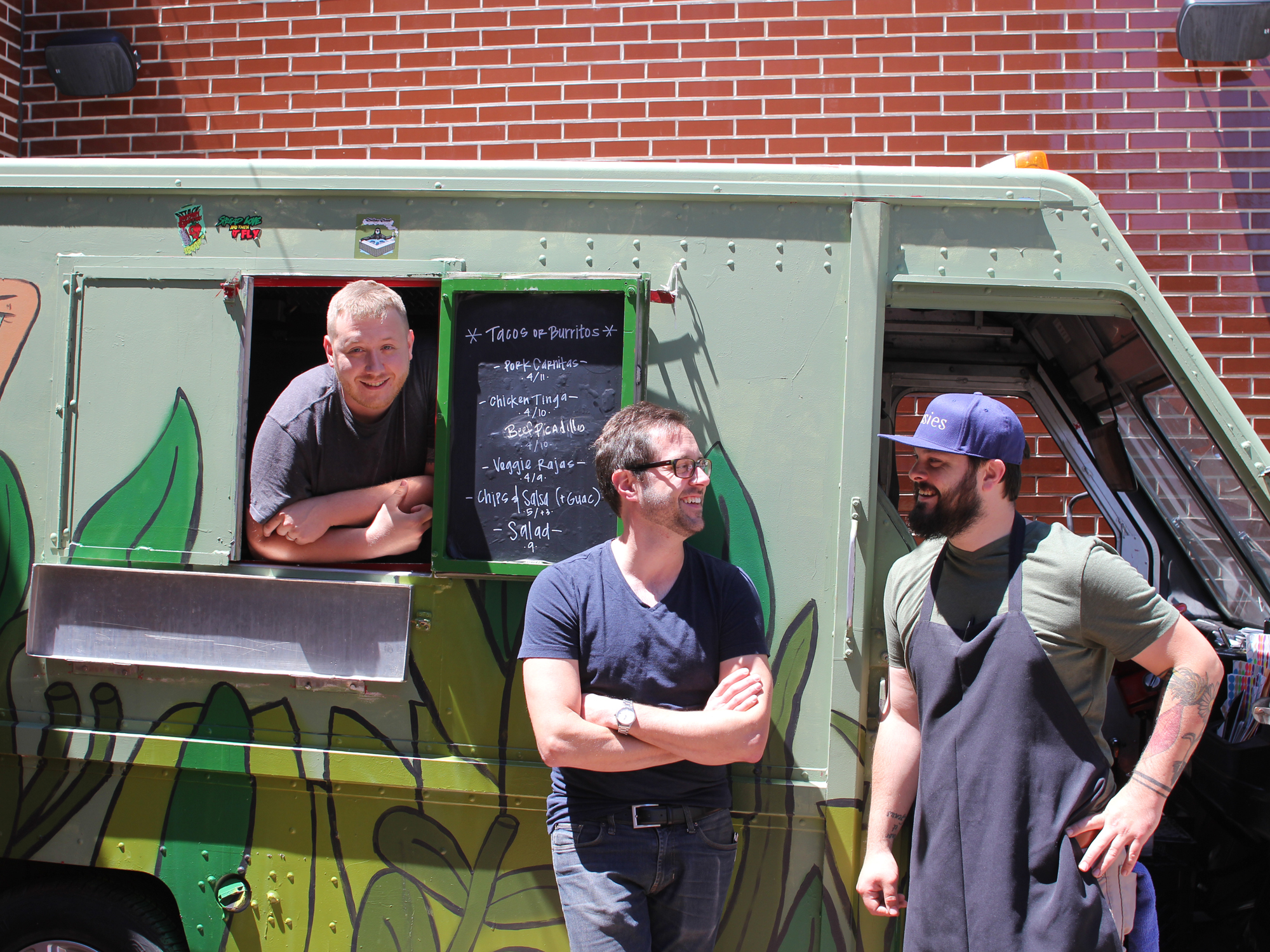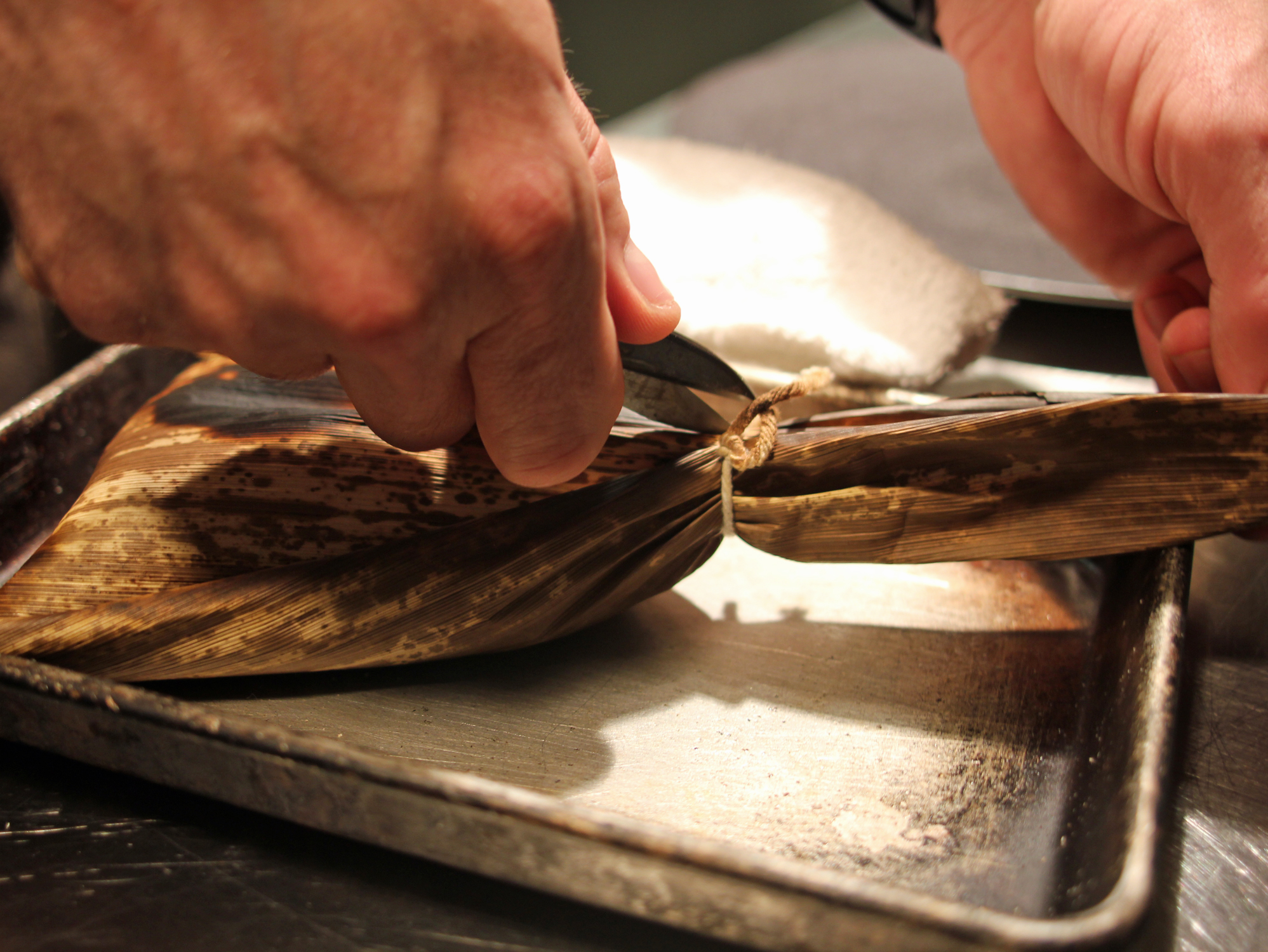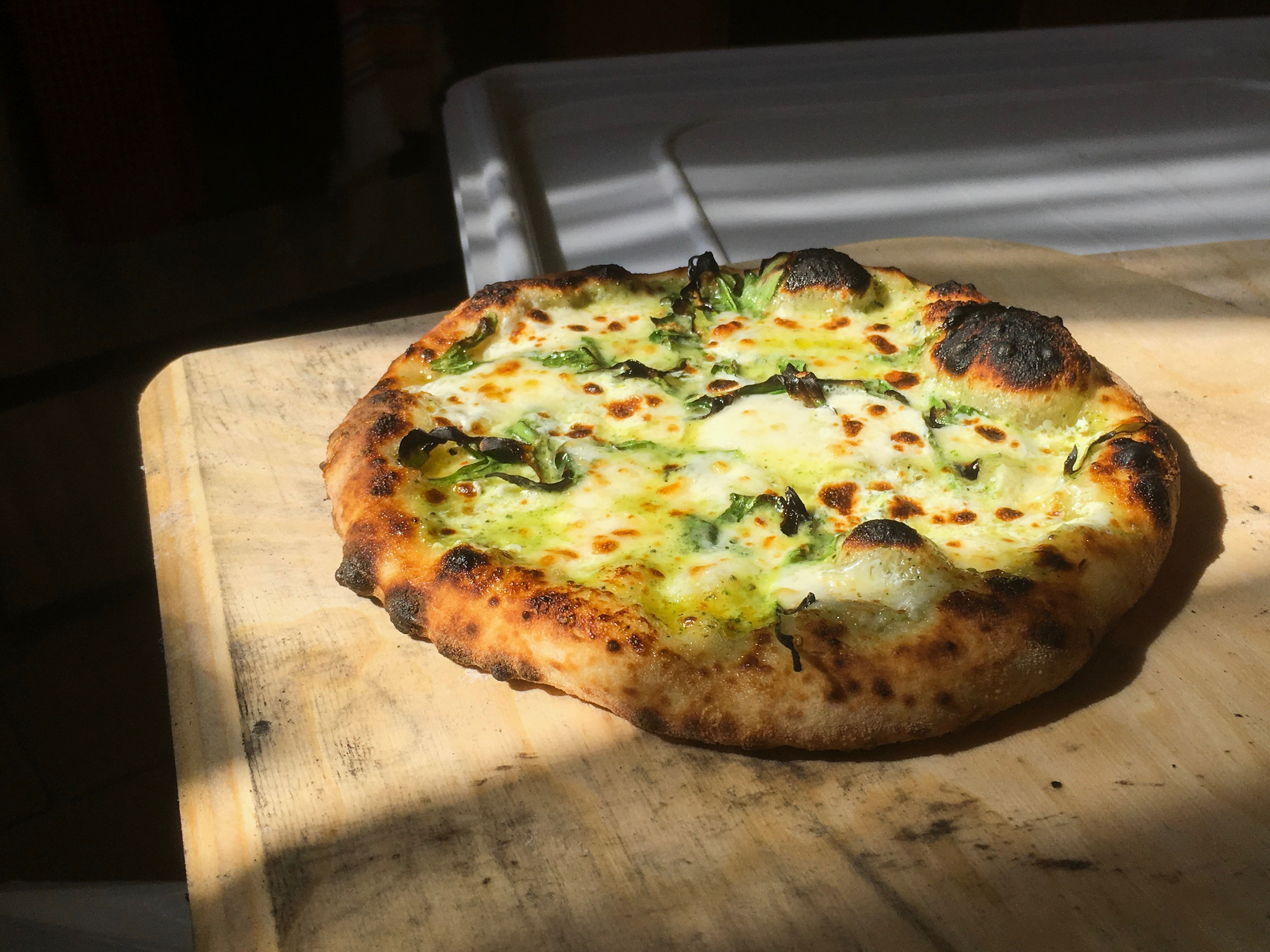IT WAS A CHANCE FOR THE NEW WORLD to show something to the old. The U.S. team for the World Pizza Championships in Salsomaggiore, Italy, had threatened to withdraw from the event unless Chicago-style stuffed pizza was allowed in competition. Leo Spizzirri, executive chef for Giordano’s in Chicago and a member of the team under San Francisco pizza legend Tony Gemignani, was excited about the chance to blow the minds of Italian pizza eaters with the beloved Chicago foodstuff. The team prepared the kind of pizza they knew Giordano’s customers in Chicago loved, and…
“The judges totally hated it. We came in last place,” Spizzirri explains in a conference room in a former warehouse in Lisle, a half hour southwest of the city. “They’re picking it up and looking under it, what the hell is this stuff? They didn’t even want to bite into it.”
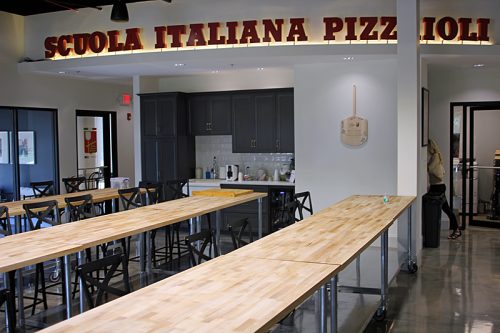
A decade later, we’re at the North American Pizza & Culinary Academy, and the only students today are a few kids attending a day camp to learn how to make pizzas. If that were the market, kids at day camp, the building would be absurd overkill—just in the main teaching space, there are dozens of seats, a kitchen that looks like Abt just installed it in a McMansion, and two full-sized Neapolitan woodburning pizza ovens. And I already know there’s more behind that.
All this is gleaming white and just a couple of weeks old—the official ribbon cutting with the mayor of Lisle will be that afternoon. I’m here with the two men behind it—Anthony Iannone, whose warehouse this was when he had a wholesale food business, and Leo Spizzirri, who, having failed to bring American deep dish to Italy, is now doing the reverse—teaching Americans how to make the five official styles of authentic Italian pizza.
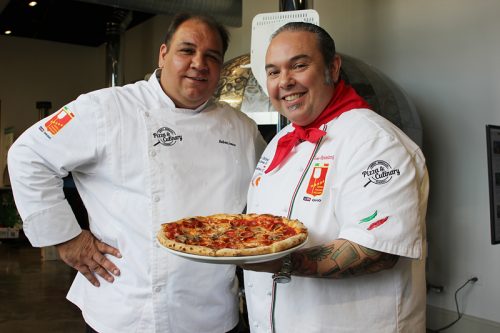
Anthony Iannone and Leo Spizzirri
“BEING A FIRST GENERATION ITALIAN-AMERICAN, my mother and grandmother right off the boat, food was a big influence in my family,” Leo Spizzirri says. “Being able to bake with my mom and grandma got me started being interested in food.”
He worked his way up through various restaurants and other kinds of food businesses. At Giordano’s, he says, “the owner had that no-holds-barred European mentality of, we do everything—today you could be running front of the house, going between locations, managing a brand new location, whatever needed to be done.”
Stuffed pizza may have flopped in Italy, but it earned Spizzirri publicity back home for trying to spread the deep dish gospel, however much it fell on barren soil. At the same time, it awakened Spizzirri’s own curiosity about Italian styles. “That’s when I took my first actual pizzaiolo course, in California, with Tony Gemignani,” he says. Gemignani in turn introduced him to Graziano Bertuzzo, headmaster of the Scuola Italiana Pizzaioli in Venice.
As he tells it, freely translating from the Italian in which they spoke, Bertuzzo told him “Whatever you’re learning in this class in California, we’re really just takin’ the wrapper off this subject. There’s so much more to learn. If you’ve got the time, you should come to Italy.”

A gas-powered oven warms up
It took him ten years of traveling back and forth, but he managed to get master certification in all five styles of Italian pizza given by the Scuola. “When you’ve got a guy who’s got all five certifications, that’s the highest level you can go in our business. So then your name goes in the hat to become an instructor,” he says. In November 2017 he went back to school in Italy—”It was a crazy five day course, every day was an exam—and if you didn’t pass that day’s exam, you were basically told not to come back the next day.”
He passed—making him one of fewer than 100 people in the world with Master Instructor certification from the Scuola. The other one in America, Tony Gemignani, had a branch of the school. So why shouldn’t he open one too in the land of pizza, Chicago?
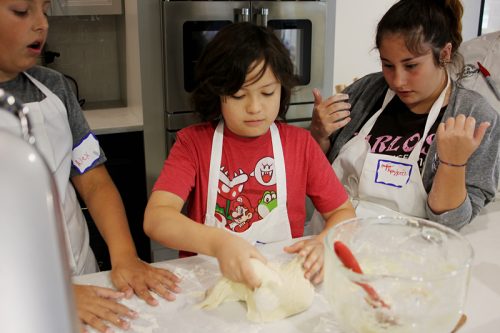
Pizzaioli of tomorrow
ANTHONY IANNONE’S STORY IS THE SAME—the same as every Italian-American in the restaurant business. “I grew up in New York,” and the way he says the city’s name leaves no doubt, Noo Yawk. “Spent my childhood in my father’s restaurant in Long Island. If you wanted to spend time with Dad, you spent it at the restaurant. My mother was a baker at home, she’d bake like crazy holidays and whatnot. I was in high school, and my home ec teacher talked me into going to culinary school.”
He went to Johnson & Wales in Providence and then Charleston, and then started working in Manhattan. From there it was all around the world—he worked in Mexico, studied in Italy, opened a restaurant in Australia. After that he became a distributor of deli meats and cheeses, running that business for seventeen years before selling it in 2017.
He was looking to see what to do next when Leo Spizzirri completed his Master Instructor certification. “He asked me, what do you think about opening up the school?”
It was clear they’d need more revenue streams in the business than the school alone. “The idea was opening up a pizzeria with a school in the back, which almost all the schools in the world are like that,” he says.
“Most of them are restaurants where, by day, when they’re not doing anything, they hold classes in there, like the theory portion, and then bring everybody in the kitchen and cook right on the line,” Leo says.
“But having the building here with a good amount of space, we thought, let’s get more into the culinary school side, and then we can put a production kitchen in,” Anthony says.
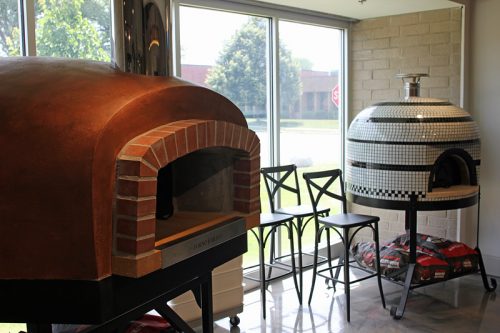
Floor models for home
In the end they built a facility to hold five different businesses. There’s the culinary academy, which is to say a place that will teach cooking skills to mostly home cooks—anybody in the suburbs who actually wants to be able to use that McMansion kitchen of theirs. There’s the pizza school, aimed more at professionals—people who want to start pizza businesses, people who have pizza businesses and suddenly realize they better learn how to make good pizza.
They do consulting for existing pizza restaurants. There’s room to do catering out of the facility. And the final piece is an equipment business—as I’ll soon learn, this is literally a showroom for all the pizza gear, all the Cadillacs and BMWs of Neapolitan pizza ovens that you could dream of.
But the heart of it is the pizza school. “We recognized that there’s a hole in our industry. There’s not a lot of people dying to get into the restaurant business,” Leo says. “We offer a place where they can learn any style, they can learn how to cook—and then, once they’re ready to pull the trigger on opening their first restaurant, we can even handle menu development, dough formulation, selling them equipment.”
The temperature is higher than normal, the humidity is heavier in the air. It feels like a seaside town in here. “It’s the exact atmosphere of Naples,” Leo explains.
Leo’s title is the one the Scuola in Italy gave him: Maestro Pizzaiolo. Anthony’s title is… he says he doesn’t have a title. He’s in charge of keeping the place going as a business, and defers to his star pizza maker.
“For me, it was unique when he first brought it to me,” Anthony says. “I grew up in the restaurant business, I’ve been rolling dough balls since I’m ten years old. But for me, in chef life, pizza was always a secondary thing to my food. I went out with him to the Pizza Expo in Vegas, and I saw how far the pizza world had come. And I said okay, we’re going to move forward and do this.”
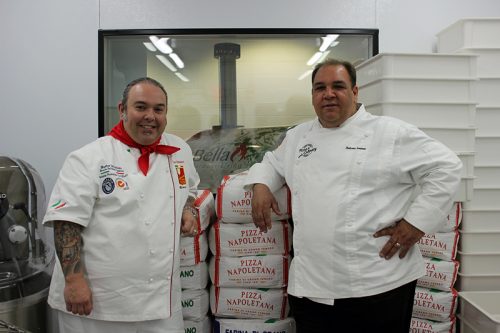
Posing with VPN-certified “00” flour from Italy
PAST THE McMANSION KITCHEN, WE ENTER A WALK-IN. I’m used to walk-ins, but I can tell something is different about this one—not just the yeasty smell in the air (I note the standard plastic bins for dough balls along one wall) but the temperature is higher than normal, the humidity is heavier in the air. It feels like a seaside town in here.
“It’s the exact atmosphere of Naples, temperature and humidity,” Leo explains.
Which brings us to the question you’ve been holding onto patiently all this time: so what are the five official styles of Italian pizza? Leo explains, “There’s three Roman styles—there’s the pizza in teglia,” tray pizza, “like at Bonci downtown. The second Roman style is the pizza al metro, the three foot long kind. The pizza is a very high-hydrated dough,” which means it gets crispier in the oven from its own steam.
“There’s Neapolitan, obviously,” he continues, “and then there’s gluten free. I used to say, I’m an expert in dough made from flour. But in the last couple of years, I’ve become interested in gluten free. That was the last kind I was certified in.”
But wait, we’re still short one Roman kind. “Then there’s what we call classic Italian. That’s the style that was taken by all the immigrants, not just from Naples but from all over Italy, and that one classic style ended up in New York. It’s not as exaggerated with that big round edge, that cornicione, that we do here in the states, but if you saw that classic style Italian pizza in Venice, you have a small edge. But it’s done with classic ingredients.”

This walk-in, as it happens, is kind of a mad pizza scientist’s dream of the ability to make any style. There are four different industrial mixers parked on the floor, from a refurbished Hobart straight out of the 1950s to a bubble-faced Italian one that looks like a robot. On the wall there’s a control panel: “With this meter over here, I can set the weight of the water, and the temperature of the water, that I want, all the way down to 35 degrees,” Leo explains. Doughs are sensitive, and bakers are almost superstitiously sensitive, to the temperature of the water you add to make a dough; what they did 200 years ago through practice and feel is now at the touch of a button.
Not hooked up yet is a water conditioner. They sent the company that made it a sample of Lisle water; they analyzed it to determine the baseline of water composition, and once installed, the machine will be able to take Lisle water, and turn it into the same chemical composition as any other water sample. You want to make New York pizza with New York water? This device will spit it out (so to speak). Not surprisingly, the name of the manufacturer is, literally, New York WaterMaker. Make it rain for New York WaterMaker!
A gleam comes in my eyes. “Have you thought of making New York bagels with real New York water?”
“We’ll totally do that,” Leo says. “How awesome would it be to actually do bagels in a real woodfired oven?”
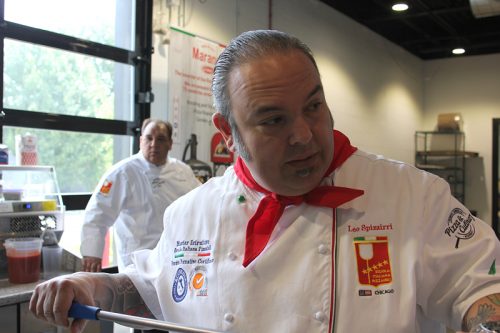
I SEE THE PRODUCTION KITCHEN—no home kitchen this, but the usual assortment of black iron you see in restaurants. Then we go to the side of the building and the showroom of working ovens—a wall of stainless steel gas-powered deck ovens, a grouping of domed, tiled Neapolitan pizza ovens with different gee-whiz features, some from Marana in Verona, Italy, some from a manufacturer in California called Forno Bravo. One of those is on wheels, so they can cook at events.
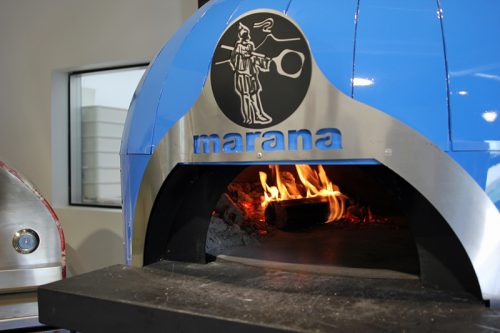
Woodburning oven from Verona
Some have gas connections, so you don’t have to worry about keeping the fire fed and the temperature consistent. One has a rotating stone so that pizzas turn themselves around in relation to the fire. Then Leo toggles a joystick on the oven and the stone raises up for automatic doming, the practice of raising a pizza on the peel to the top of the oven, where it’s often a couple of hundred degrees hotter than on the stone. It gives you a quick crisping up of edges on meats or tomatoes or whatever is on your pizza. “This is actually the oven that won the Guinness Book of World Records for most pizzas cooked in an hour by one person,” Leo says.
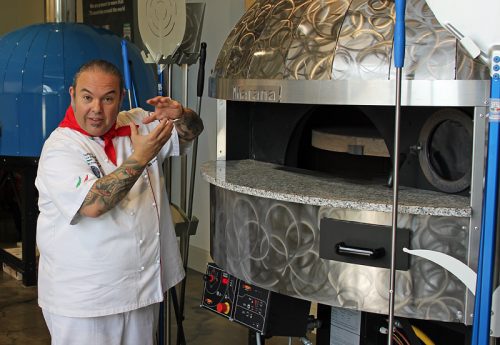
Leo demonstrates the rising stone deck, for doming a whole oven full of pizzas
One—and the set of tools next to it—is reserved strictly for gluten free baking, so there’s no cross contamination. “When we’re teaching gluten free pizza, we’re teaching that even the tools matter,” Leo says.
It’s almost noon and we drove a long way, so it’s time for pizza. Leo takes a dough ball and starts making it into a circle with his fingers, then starts rapidly flipping it with his hands into the size of a pizza. He adds pepperoni and mushrooms, then slides it into one of the stone ovens.
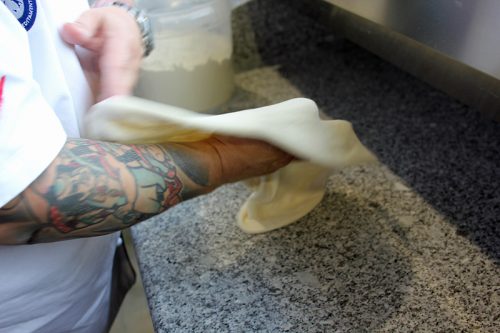
“This oven, because it hasn’t made a pizza yet this morning, the surface is very hot,” Leo explains. “The gas flame just went on, but even without the flame, you can see that the edges are already starting to get puffed up.”
“The cheese is already starting to melt. The pepperoni is already starting to cup up. It’s a very quick process.”
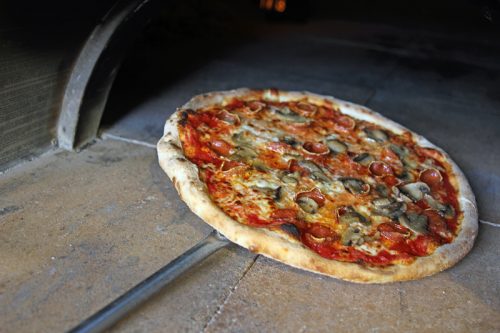
In barely two minutes, pizza, a textbook Neapolitan. We devour it quickly.
Next he brings out a pizza al teglio dough, a big floppy rectangle of bread in a tray. This style is typically placed in the oven three times—once to par-bake the crust, a second time to bake the toppings on it, and the third to warm a slice when it’s ordered. In this case, we’ll eat it fresh from the oven, so it will only bake twice.
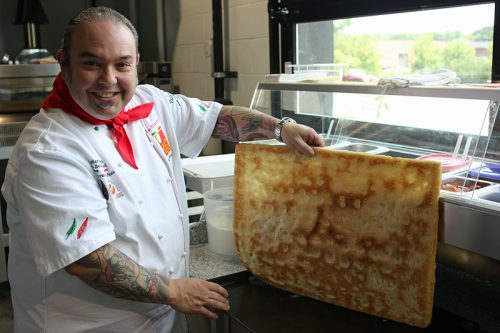
The puffy crust of pizza al teglio
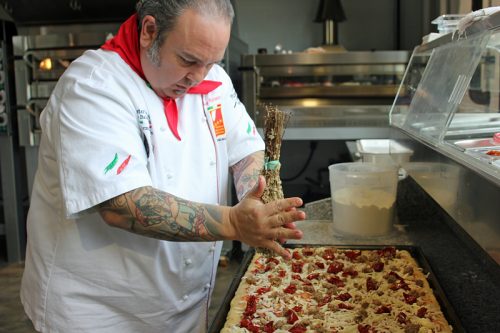
Rubbing a bundle of dried oregano, from Calabria. “It’s amazing to see the difference when it’s right off the branch,” Leo says.
Leo puts sausage and sun-dried tomatoes on the pizza, then it goes in the deck oven for about ten or twelve minutes. Square and puffy, it looks like a lot of the pan pizza you see in America, but the tang of the dough and the quality of the ingredients are way above that.
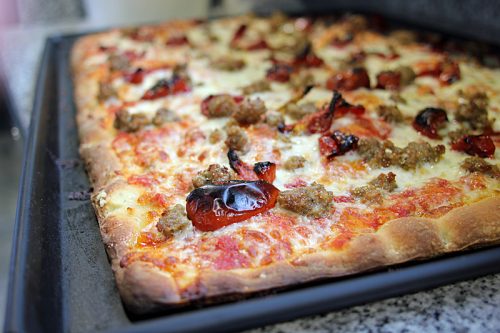
Again, we dig in heartily, happy to help them test out their ovens in advance of today’s ribbon-cutting ceremony. Happy… because pizza is happiness. A fact that was obvious as soon as we walked in and saw the kids rolling out dough in the classroom.
“I walk in here every day and I still can’t believe this place is mine,” Leo says, his round face opening wide with a grin. “It’s a dream workin’ here. It’s awesome.”
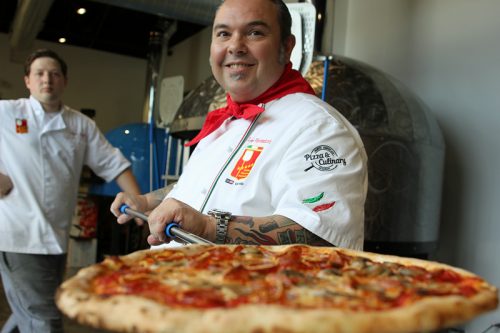
Michael Gebert is the maestro scrittore of Fooditor.
Latest
Join the Discussion
After you comment, click Post. If you're not already logged in you will be asked to log in or register with Disqus.





